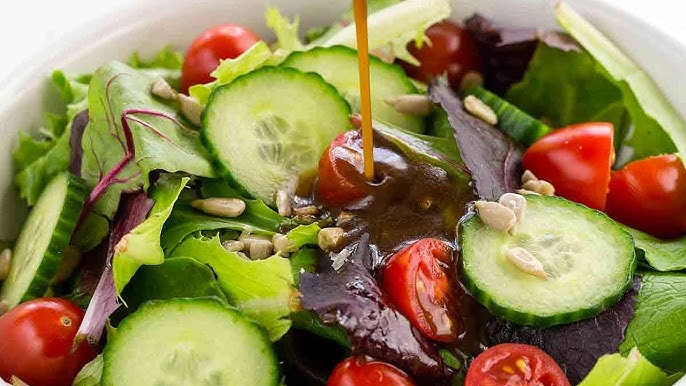Vinaigrette Salad Dressing Recipe: There’s something magical about a good vinaigrette. It’s light, tangy, and pulls together the flavors of a salad like the final brushstroke on a masterpiece. But here’s the thing: store-bought dressings often come packed with preservatives, sugar, and artificial flavors. So why not make your own? This guide will walk you through everything—from the ingredients to detailed step-by-step instructions—so you can whip up the perfect vinaigrette right in your kitchen. And yes, it’s way easier than you think!
What is a Vinaigrette?
Let’s start with the basics. A vinaigrette is a type of salad dressing made by mixing oil with something acidic, like vinegar or lemon juice. It’s a French classic and one of the most versatile dressings out there. The magic happens when you mix the oil and acid together—they don’t naturally blend, so you whisk them until they temporarily emulsify, giving you a smooth, flavorful dressing.
It’s usually seasoned with salt and pepper and often enhanced with mustard, garlic, herbs, or even a touch of honey. This dressing isn’t just for salads either—it’s a game-changer on grilled vegetables, pasta salads, and even as a marinade for meat or tofu.
The beauty of vinaigrette lies in its flexibility. You can customize it endlessly. Want it tangier? Add more vinegar. Need a sweeter note? Toss in a little honey or maple syrup. Prefer something with a kick? A pinch of chili flakes can do wonders. Once you understand the foundational ratio, you can go wild with creativity.
Why Make Your Own Vinaigrette at Home?
You might wonder, “Why go through the trouble when I can just grab a bottle from the store?” Here’s why homemade vinaigrette wins—every single time:
- Freshness: Store-bought versions can sit on shelves for months. Homemade vinaigrette? Always fresh and full of vibrant flavor.
- No Nasties: You control what goes in—no preservatives, artificial flavorings, or excess sugar.
- Customization: Tailor it to your exact taste. Love garlic? Add more. Hate sweetness? Skip the sugar.
- Cost-Effective: Basic ingredients like oil and vinegar go a long way, saving you money in the long run.
Also, making vinaigrette is quick—like, shake-it-in-a-jar-and-you’re-done quick. Once you’ve tried your own, it’s hard to go back. It’ll become your go-to dressing, trust me.
Ingredients You’ll Need
Basic Vinaigrette Ingredients
At its core, vinaigrette only needs a few simple pantry staples. Here’s the minimalist list:
- Olive oil (or any neutral oil)
- Vinegar (like red wine vinegar, white wine vinegar, or apple cider vinegar)
- Salt and pepper
Now, if you want to go from “basic” to “brilliant,” consider adding:
- Dijon mustard – helps emulsify and adds sharpness
- Minced garlic or shallots – for flavor depth
- Honey or maple syrup – adds balance and a hint of sweetness
That’s it. No fancy ingredients. No complicated steps. Just real food and real flavor.
Optional Add-ins for Extra Flavor
Once you’re comfortable with the base, try some fun add-ins to make your vinaigrette stand out:
- Herbs: Fresh or dried parsley, oregano, thyme, basil, or dill.
- Spices: Crushed red pepper, cumin, smoked paprika.
- Zest: Lemon or orange zest adds brightness.
- Parmesan or nutritional yeast: For a cheesy twist.
- Soy sauce or tamari: Adds umami depth.
These aren’t just for show. They transform your vinaigrette into a gourmet experience that can turn a simple salad into a memorable dish.
Choosing the Right Vinegar and Oil
Not all oils and vinegars are created equal. Choosing the right ones can elevate your dressing to restaurant-quality. Here’s what to know:
Best Oils for Vinaigrette:
- Extra virgin olive oil: Rich and flavorful, great for most salads.
- Avocado oil: Light and healthy, with a neutral taste.
- Grapeseed or sunflower oil: Milder, great if you don’t want the oil to overpower.
Best Vinegars:
- Red wine vinegar: Sharp and tangy.
- Apple cider vinegar: Slightly sweet, full of health benefits.
- Balsamic vinegar: Sweet and robust, perfect for deeper flavor.
- Rice vinegar: Mild and slightly sweet, ideal for Asian-inspired dressings.
- Sherry vinegar: Complex and nutty—underrated but amazing.
You can mix and match to suit the dish or your taste. For instance, balsamic with olive oil is perfect for a Caprese salad, while rice vinegar and sesame oil work great for Asian slaws.
Equipment You’ll Need
Simple Tools from Your Kitchen
You don’t need fancy gadgets to make vinaigrette. In fact, you probably already have everything:
- Small mixing bowl
- Whisk or fork
- Measuring spoons and cups
- Mason jar with a lid (great for shaking it all up)
Using a whisk allows you to emulsify the dressing quickly. But if you’re in a rush, tossing all the ingredients in a jar and giving it a good shake works just as well.
Alternatives for Mixing Without a Blender or Whisk
Don’t have a whisk handy? No worries. Try these alternatives:
- Shake it in a jar – Super effective and zero cleanup.
- Use an immersion blender – Great if you want an ultra-smooth texture.
- Fork + elbow grease – Old school but it works!
The key is getting the oil and vinegar to emulsify—that creamy look where they don’t separate right away. Once you get the hang of it, you’ll be making vinaigrettes in your sleep.
Step-by-Step Guide to Making Vinaigrette
Let’s get down to the heart of this article. Ready to make your own vinaigrette? Follow these steps:
Step 1: Measure the Ingredients
Begin by measuring your basic vinaigrette ratio — 1 part vinegar to 3 parts oil. Use about 1 tablespoon of vinegar and 3 tablespoons of olive oil for a small batch. Gather Dijon mustard, salt, pepper, and any herbs or sweeteners like honey or maple syrup for balance.
Step 2: Combine Vinegar, Mustard, and Seasonings
In a bowl, whisk together the vinegar, Dijon mustard, salt, pepper, and any optional flavorings. The mustard acts as an emulsifier, helping your vinaigrette blend smoothly instead of separating.
Step 3: Slowly Add Oil and Whisk
While whisking continuously, drizzle in the olive oil a few drops at a time. This slow incorporation helps the mixture emulsify and become silky.
Step 4: Taste and Adjust to Preference
Taste your vinaigrette and tweak as needed — add more vinegar for tang, oil for smoothness, or honey for sweetness. Once perfect, drizzle it over salads, roasted veggies, or grilled meats for a burst of bright, fresh flavor.
Vinaigrette Ratios and Variations
Classic 3:1 Ratio Explained
The backbone of most vinaigrette recipes is the 3:1 oil-to-vinegar ratio. This standard balance delivers a mildly tangy flavor with a rich, smooth body. Here’s how it works:
- 3 parts oil (like olive oil)
- 1 part vinegar (like red wine vinegar)
For example:
- 6 tablespoons olive oil
- 2 tablespoons vinegar
This gives you about ½ cup of dressing—perfect for a dinner salad serving 3–4 people.
But don’t treat this ratio as law. Some vinegars are milder (like rice vinegar or balsamic), and you might prefer a 2:1 ratio instead for a punchier bite. Play with the proportions depending on the ingredients and your personal taste.
Adjusting for Different Cuisines
Want to pair your vinaigrette with a specific style of cuisine? Here are some ideas to tweak your base recipe:
- Italian: Use red wine vinegar, oregano, garlic, and olive oil.
- Asian-inspired: Rice vinegar, sesame oil, soy sauce, ginger, and garlic.
- Mexican: Lime juice, cumin, cilantro, and olive oil.
- French-style: Shallots, Dijon mustard, white wine vinegar, and a touch of tarragon.
Each twist changes the character of the dressing without much effort. It’s a fantastic way to match your salad dressing to your main course and elevate your meal.
Sweet vs. Savory Vinaigrette
Another fun direction to take your vinaigrette is deciding whether you want it sweet, savory, or balanced.
Sweet vinaigrettes are great for:
- Fruit-based salads
- Dishes with roasted squash or beets
- Salads with candied nuts or cranberries
Try ingredients like:
- Honey
- Maple syrup
- Orange juice
- Balsamic vinegar (naturally sweeter)
Savory vinaigrettes shine with:
- Grilled or roasted vegetables
- Grain salads
- Protein-packed bowls
Use:
- Dijon or whole-grain mustard
- Garlic
- Anchovy paste or Worcestershire
- Soy or tamari
Mixing and matching sweet and savory elements gives you endless room to experiment. You can balance honey with mustard, or add lemon juice to cut through balsamic’s sweetness. It’s all about contrast and harmony.
Common Mistakes to Avoid
Overpowering the Dressing with Too Much Vinegar
One of the biggest rookie mistakes when making vinaigrette is going heavy on the vinegar. You might think you’re adding bold flavor, but if you overdo it, the dressing turns acidic and harsh, masking the salad’s freshness.
How to avoid this:
- Stick to the 3:1 or 2:1 oil-to-vinegar ratio.
- Always taste before serving.
- Balance with a bit of sweetness or extra oil if needed.
Remember: The acid is there to brighten, not dominate.
Not Emulsifying Properly
When oil and vinegar don’t combine well, you’re left with a separated, oily mess that doesn’t coat the salad evenly. This usually happens when:
- You pour oil too quickly.
- You don’t whisk or shake vigorously.
- You skip mustard or an emulsifier.
To fix it:
- Start over and add oil gradually.
- Use mustard, garlic paste, or even a small amount of mayo for better emulsification.
- Shake in a sealed jar for 30 seconds minimum.
Even if your vinaigrette separates, a quick shake or whisk right before serving usually brings it back together.
Skipping the Tasting Step
If you’re not tasting your dressing before pouring it over your salad, you’re doing yourself a disservice. Salads can vary wildly in flavor and texture—some are bitter, some sweet, some delicate, others hearty.
Taste test tips:
- Dip a lettuce leaf into the vinaigrette instead of just using a spoon.
- Consider what you’re dressing—delicate greens need lighter flavor, while kale or grains can handle bolder notes.
- Adjust acidity, salt, and sweetness as needed.
Tasting and adjusting ensures your dressing complements your salad perfectly instead of clashing with it.
Flavor Variations You Can Try
Lemon Herb Vinaigrette
This fresh and zesty version is perfect for spring and summer salads. The lemon gives it a citrusy tang while fresh herbs elevate the flavor with an earthy brightness. Here’s what you need:
- 3 tablespoons olive oil
- 1 tablespoon fresh lemon juice
- 1 teaspoon Dijon mustard
- 1 teaspoon honey (optional)
- 1 garlic clove, finely minced
- 1 tablespoon chopped fresh herbs (parsley, basil, thyme, or dill)
- Salt and pepper to taste
Whisk all ingredients together until emulsified. This vinaigrette pairs beautifully with arugula, baby spinach, or a quinoa and veggie bowl. The combination of citrus and herbs brings a refreshing flavor that feels like sunshine in a bottle. Plus, it doubles as a quick marinade for grilled chicken or shrimp.
Balsamic Vinaigrette
A richer, slightly sweeter variation, balsamic vinaigrette is a crowd-pleaser and goes great with Mediterranean and Italian-inspired salads. The deep flavor of balsamic vinegar combined with olive oil creates a velvety, robust dressing. Here’s a simple version:
- 3 tablespoons extra virgin olive oil
- 1 tablespoon balsamic vinegar
- 1 teaspoon Dijon mustard
- 1 garlic clove, minced
- 1 teaspoon maple syrup or honey
- Salt and freshly ground black pepper
This dressing is perfect on mixed greens with goat cheese and strawberries, or drizzled over roasted vegetables. For a creamier twist, add a teaspoon of mayonnaise or Greek yogurt. It’s also amazing over a Caprese salad with fresh mozzarella, basil, and tomatoes.
Honey Mustard Vinaigrette
If you’re craving something sweet and tangy, honey mustard vinaigrette hits the spot. This one’s a favorite for both kids and adults because of its balanced, approachable flavor. Here’s a go-to recipe:
- 3 tablespoons olive oil
- 1 tablespoon apple cider vinegar
- 1 tablespoon Dijon mustard
- 1 tablespoon honey
- Salt and pepper to taste
Whisk until smooth and creamy. This dressing is ideal for cabbage slaws, grilled chicken salads, or as a dipping sauce for roasted veggies. It’s creamy without dairy and sweet without refined sugar—a total win.
You can spice it up with a touch of cayenne pepper or add chopped shallots for texture.
Best Salads to Pair With Vinaigrette
Light Leafy Greens
Vinaigrettes shine brightest when paired with tender, light greens that can absorb flavor without getting soggy. Think:
- Arugula
- Butter lettuce
- Baby spinach
- Mixed spring greens
These greens are delicate and benefit from a lightly acidic dressing that lifts their natural flavors. Try a lemon vinaigrette with arugula and shaved Parmesan, or a classic red wine vinaigrette with mixed greens, cucumber, and radish. Avoid drowning them—just a light toss is enough.
A great tip? Add your vinaigrette right before serving. Letting delicate greens sit too long in the dressing can cause them to wilt.
Hearty Grain-Based Salads
Vinaigrette isn’t just for green salads—it’s a game-changer for grain-based salads like:
- Quinoa bowls
- Farro or barley salads
- Couscous or bulgur wheat mixes
- Wild rice salads
These ingredients can absorb vinaigrette beautifully, making them more flavorful over time. Use a tangy mustard vinaigrette with lentils and quinoa, or a balsamic blend with roasted sweet potato and farro. Since these grains hold up well, they’re perfect for meal prep too.
Letting the salad sit for a few hours after dressing can actually improve the flavor as the grains soak up all that goodness.
Roasted Vegetable Salads
Roasted veggies have a deep, caramelized flavor that pairs incredibly well with a punchy vinaigrette. Try tossing the following with a balsamic or red wine vinaigrette:
- Roasted carrots and beets
- Cauliflower and chickpeas
- Zucchini, eggplant, and red onion
- Sweet potatoes and Brussels sprouts
Add in some feta, toasted seeds, or nuts, and you’ve got a full meal. The contrast of warm, savory veggies and cool vinaigrette creates a satisfying flavor balance you’ll want to keep coming back to.
Storing Your Homemade Vinaigrette
How Long Does It Last?
Homemade vinaigrette can last up to 1–2 weeks in the fridge when stored properly. The key is storing it in a sealed, airtight container—preferably glass. A mason jar works perfectly.
Keep in mind that vinaigrettes with fresh ingredients like garlic, herbs, or lemon juice tend to spoil faster—more like 5–7 days. If you’re making a batch for the week, use clean utensils each time you scoop some out to avoid introducing bacteria.
Oil can solidify in the fridge, especially if you’re using olive oil. No problem—just set the vinaigrette at room temperature for 10–15 minutes and shake it up again before using.
Signs It’s Gone Bad
Always check before pouring! Vinaigrette that’s spoiled will usually show:
- A sour or off smell
- Separation that doesn’t re-blend
- Mold or cloudiness in the container
- Bitter or rancid flavor
When in doubt, toss it out. Better safe than sorry.
Storage Containers That Work Best
Your vinaigrette deserves good storage. Use:
- Glass jars with tight lids (mason jars, old jam jars)
- Squeeze bottles (great for controlled pouring)
- Mini salad dressing containers for lunch boxes
Avoid plastic containers if possible, especially for long-term storage, as oil can absorb plastic odors and flavors. Glass is always your best bet.
Label your jars with the date made and the type of vinaigrette so you remember what’s inside and how long it’s been in there.
Nutritional Benefits of Homemade Vinaigrette
Control Over Ingredients
Making vinaigrette at home puts you in the driver’s seat. No more worrying about hidden sugars, preservatives, or low-quality oils. You choose every single ingredient, so it’s easy to tailor the dressing to your nutritional needs and taste preferences.
Want to cut sodium? Use less salt. Watching sugar intake? Skip the sweetener or use natural alternatives. The control is empowering—and tasty.
Fewer Preservatives and Additives
Store-bought dressings often contain:
- Stabilizers
- Emulsifiers
- Artificial flavors
- High-fructose corn syrup
Even “healthy” brands sneak in unnecessary extras. Homemade vinaigrette is naturally clean. Just oil, vinegar, and a few pantry staples. No mystery ingredients.
Plus, you can opt for organic, non-GMO, or locally sourced products to make your dressing even better.
Healthier Fats and Natural Sweeteners
Using high-quality oils like extra virgin olive oil or avocado oil gives your body healthy monounsaturated fats—great for heart health and lowering inflammation.
You can also control the type and amount of sweetener. Prefer low-glycemic options? Use:
- Maple syrup
- Raw honey
- Coconut sugar
- Stevia (sparingly)
Making vinaigrette from scratch is a small change with a big health impact. And because it’s so easy to make, you’ll be less tempted by those plastic bottles at the store.
Scaling the Recipe Up or Down
Making Small Batches for Daily Use
One of the best parts of making vinaigrette is how easy it is to scale. If you’re preparing just a small salad for lunch or dinner, you don’t need to whip up a big batch—a few tablespoons will do just fine.
Here’s a mini version of the classic vinaigrette ratio:
- 1 tablespoon olive oil
- 1 teaspoon vinegar
- ½ teaspoon mustard
- Pinch of salt and pepper
- Optional: a drop of honey or sprinkle of garlic
You can shake this up in a small jar or whisk in a ramekin—no fancy tools needed. It’s fast, fresh, and ensures you’re not storing excess dressing for days. Plus, the smaller the batch, the more likely you’ll use it all up in one go, keeping flavors fresh and waste minimal.
For those who eat salads daily, prepping a small jar (½ cup or less) once every few days is a great habit. It ensures you always have fresh, homemade dressing on hand without having to make it from scratch each time.
Preparing Larger Quantities for Parties or Meal Prep
Feeding a crowd? Hosting a dinner party? Or just love prepping ahead for the week? No problem—vinaigrette is incredibly easy to scale up.
Just maintain the ratio:
- 3 parts oil
- 1 part vinegar
Example for a party:
- ¾ cup olive oil
- ¼ cup vinegar
- 1 tablespoon Dijon mustard
- 2 teaspoons honey
- 1 garlic clove, minced
- Salt and pepper to taste
Whisk or blend, then pour into a large mason jar or carafe. You’ll have enough to dress 2–3 big salads or marinate several proteins and veggies. The longer it sits, the more the flavors meld together—so making it a day ahead actually enhances the taste.
Make sure to store it well (glass jars are ideal), and give it a good shake before each use, especially if the oil has separated.
Vinaigrette for Special Diets
Vegan and Gluten-Free Options
Vinaigrette is naturally a great fit for many special diets, including vegan and gluten-free lifestyles. Here’s how to make it work:
- Oil and vinegar are both naturally vegan and gluten-free.
- Use Dijon mustard without eggs (check the label) for vegan recipes.
- Opt for apple cider vinegar, balsamic, or rice vinegar—all gluten-free options.
- Swap honey for maple syrup or agave nectar to keep it plant-based.
Always check your labels—especially with mustard, soy sauce, and specialty vinegars. Some may contain gluten or animal by-products.
Pro tip: Add nutritional yeast for a cheesy, umami-rich flavor that’s completely vegan.
Low-Sodium and Keto-Friendly Tips
For those watching sodium or carbs, vinaigrette can be easily tailored:
Low-Sodium Tips:
- Omit added salt and use herbs and spices instead.
- Use fresh garlic, lemon zest, or mustard for flavor.
- Add a splash of citrus for brightness without the salt.
Keto-Friendly Tips:
- Stick to healthy fats like olive oil, avocado oil, or MCT oil.
- Use apple cider vinegar or lemon juice for acidity.
- Sweeten with a small amount of stevia, erythritol, or omit sweetener entirely.
Keto vinaigrette is rich in healthy fats and low in carbs—perfect for those aiming to stay in ketosis while still enjoying bold salad flavors.
Troubleshooting Your Vinaigrette
What to Do if It Separates
Oil and vinegar are natural enemies. If left alone, they’ll almost always separate. But don’t worry—it doesn’t mean your vinaigrette is ruined.
To re-emulsify:
- Shake vigorously in a jar for 10–20 seconds.
- Whisk quickly in a bowl to recombine.
- Use an immersion blender for a more permanent blend (especially helpful for larger batches).
To prevent separation in the first place, always use an emulsifier like:
- Dijon mustard
- Garlic paste
- A touch of mayo or egg yolk (for creamy dressings)
Still separates too quickly? Try adding a bit more mustard or blend longer.
How to Fix If It’s Too Tart or Too Oily
Too Tart?
- Add more oil (½ tablespoon at a time)
- Stir in a small amount of sweetener (like honey or syrup)
- Toss in a teaspoon of Greek yogurt or cream to mellow the acid
Too Oily?
- Add more vinegar or lemon juice (1 teaspoon at a time)
- Include extra mustard or herbs to cut the oiliness
- Use a pinch of salt or acid like lime juice to bring balance
It’s all about taste and balance. With practice, you’ll get better at adjusting on the fly and finding that sweet spot where the dressing elevates everything it touches.
FAQs about Vinaigrette Salad Dressing Recipe
1. Can I Use Lemon Juice Instead of Vinegar?
Absolutely! Lemon juice makes a deliciously fresh and tangy base for vinaigrette. It’s slightly less acidic than most vinegars, so you may need a little extra to reach the same punch. It’s especially good with fresh herbs or for citrus-themed salads.
2. What’s the Best Oil for Vinaigrette?
Extra virgin olive oil is the gold standard, but other oils like avocado, walnut, grapeseed, or sunflower also work well. Choose based on flavor—stronger oils for bold salads, milder ones for delicate greens.
3. Can I Freeze Homemade Vinaigrette?
Freezing vinaigrette is not recommended, especially those with mustard or garlic, as it can affect texture and flavor. However, you can refrigerate it for 1–2 weeks. If oil solidifies, just let it sit at room temp and shake before use.
4. How Can I Make It Creamier?
Add a small spoonful of Greek yogurt, mayonnaise, tahini, or even mashed avocado to thicken and give your vinaigrette a creamy consistency. It also helps emulsify and adds richness.
5. What’s the Shelf Life of Homemade Dressing?
Basic vinaigrette without fresh ingredients can last up to 2 weeks in the fridge. If it includes garlic, lemon juice, or herbs, use it within 5–7 days for optimal freshness and safety.
Conclusion
Making your own vinaigrette salad dressing is one of the easiest and most rewarding things you can do in the kitchen. With just a few ingredients, a bowl, and a whisk (or even a jar and a shake), you can craft a dressing that’s fresh, flavorful, and perfectly suited to your taste buds.
Whether you like it sweet, tangy, herby, or spicy, vinaigrette is endlessly customizable and works with everything from leafy greens to roasted veggies and grain bowls. It saves money, ditches the preservatives, and gives you full control over your ingredients.
So the next time you reach for that store-bought bottle, stop and consider: you’ve got everything you need to make something better, fresher, and healthier—right in your kitchen. Give it a try, taste as you go, and get creative. Your salads will thank you.



